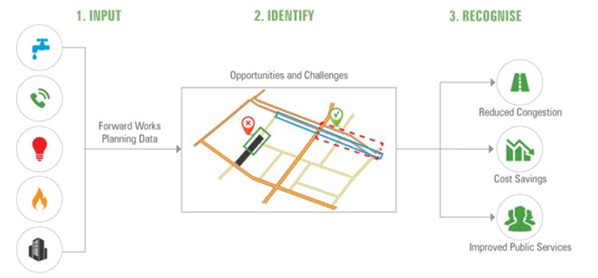
Adapting to the needs of a changing world, MISS DIG 811 offers the Collaborative Design program. Building on our long-standing design ticket, this is a holistic approach to coordination. The program optimizes engagement of all current and future infrastructure owners, maximizing the investment and minimizing disruption to hard surfaces, existing infrastructure, and the public.
The Michigan Infrastructure Commission (MIC) reported a multi-billion-dollar requirement in annual updates for decades to come. The State of Michigan believes that the foundation of success in managing such a significant number of projects is cooperation between potentially conflicting projects during the design process. The MISS DIG 811 Collaborative Design Program addresses these challenges.
Collaborative Design is built on the WorksAccess platform. The program allows for communication, collaboration, and scheduling of work. It has the ability to unite involved parties by providing a platform on which they can communicate excavation and coordinate schedules to reduce the number of road openings and associated costs through shared excavation prior to a dig ticket being submitted and ground being broken. The program will:
- Provide opportunity to share excavation costs.
- Extend road life.
- Improve utility design.
- Reduce risk for utility strikes and damages through better design.
- Improve community awareness of projects.

Through the MISS DIG 811 Collaborative Design Program, users can upload and share project plans, communicate between projects, isolate challenges and opportunities with other projects in the area, and schedule and agree to shared excavation or schedule changes. The program is built on four basic principles:
- Job: A project with a defined location and description entered by a utility user
- Opportunity: Two or more jobs with similar start and end dates that do not overlap are within 330 feet of one another
- Challenge: Two or more jobs with start and end dates that overlap within 330 feet of one another
- Exclusion Zones: An area which generates notifications designed to indicate specific constraints on work being permitted (e.g. a road moratorium or protected area)
Additionally, the program allows the designer to change visibility of a job based on the stage of the project, allowing users to manage whether it is for internal or public viewing. All jobs follow the same visibility hierarchy:
- Draft (for internal use)
- Private (shared with territory owner)
- Public (shared with other organizations)
From the dashboard users can select any of their jobs; this screen gives a bird’s eye view of all projects/jobs the company has on the system and provides the ability to view:
- Attachments
- Opportunities
- Challenges
- Collaborators
- Conversations
The MISS DIG 811 Collaborative Design Program allows users to navigate through a list of jobs their organization has entered. All jobs can be edited and modified to ensure that the project is defined correctly in terms of its geographic boundary, schedule, details, and visibility to other users. The conversations feature allows for multi-organizational discussion and the uploading of attachments to support the collaboration. As a tool, users can start a conversation with any other jobs that have been identified as being an “opportunity" or a "challenge" to the selected job. Facility owners will still have ten business days to respond to a design ticket, providing the size, type, and general location of their infrastructure.

